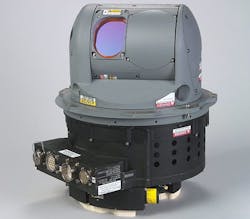Air Force orders LAIRCM laser-based missile-defense systems for large military aircraft
WRIGHT-PATTERSON AFB, Ohio, 20 April 2016. Missile-defense experts at Northrop Grumman Corp. will install LAIRCM laser-based missile-defense systems for large military aircraft under terms of a $87.2 million contract modification announced last Friday.
Officials of the Air Force Life Cycle Management Center at Wright-Patterson Air Force Base, Ohio, are asking engineers at the Northrop Grumman Mission Systems segment in Rolling Meadows, Ill., to provide the electro-optical Large Aircraft Infrared Counter Measures ( LAIRCM) for a variety of U.S. military aircraft.
LAIRCM automatically detects a missile launch, determines if it is a threat, and activates a high-intensity laser-based countermeasure system to track and defeat the missile, Northrop Grumman officials say.
The system is for Air Force C-5, C-17, C-37, and C-40 cargo and utility jets; Air Force C-130H and MC-130W four-engine utility turboprop aircraft, the CV-22 tiltrotor aircraft, the KC-46 aerial refueling jet, as well as the U.S. Navy P-3 maritime patrol jet. LAIRCM also can fit on some large military helicopters.
LAIRCM focuses high-intensity laser energy at the infrared seeker head of incoming missiles to blind the missile and force it off its target. The system is designed to protect large aircraft from shoulder-fired, vehicle-launched, and other infrared-guided missiles when the planes are operating close to the ground, such as on takeoff and landing, as well as during low-level operations and aerial refueling.
Initial LAIRCM systems equipped C-17 and C-130 aircraft as a stop-gap measure, using an ultraviolet sensor, a countermeasure processor, and a small laser turret assembly.
Later-model LAIRCM systems use a smaller laser turret, and operate in the infrared region. Compared to first-phase LAIRCM systems, the newer models provide better resolution, better performance in optical clutter, and increased range of detection.
In the future military leaders are trying to develop aircraft-protection infrared countermeasures able to detect and classify incoming missiles, then emit a custom jamming energy to defeat them.
On this contract modification Northrop Grumman will do the work in Rolling Meadows, Ill., and should be finished by April 2018. For more information contact Northrop Grumman Mission Systems online at www.northropgrumman.com, or the Air Force Life Cycle Management Center at www.wpafb.af.mil/aflcmc.

